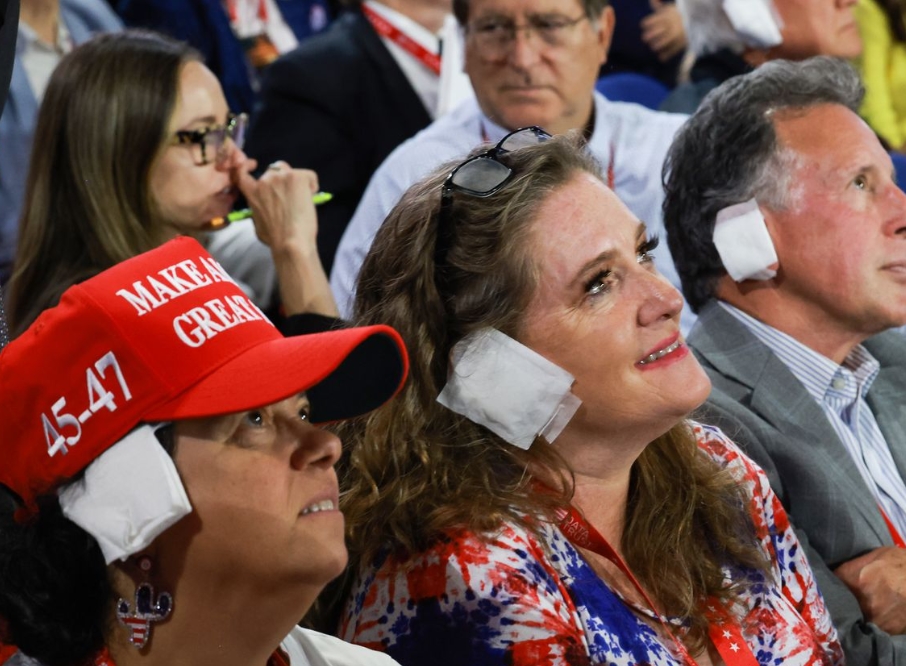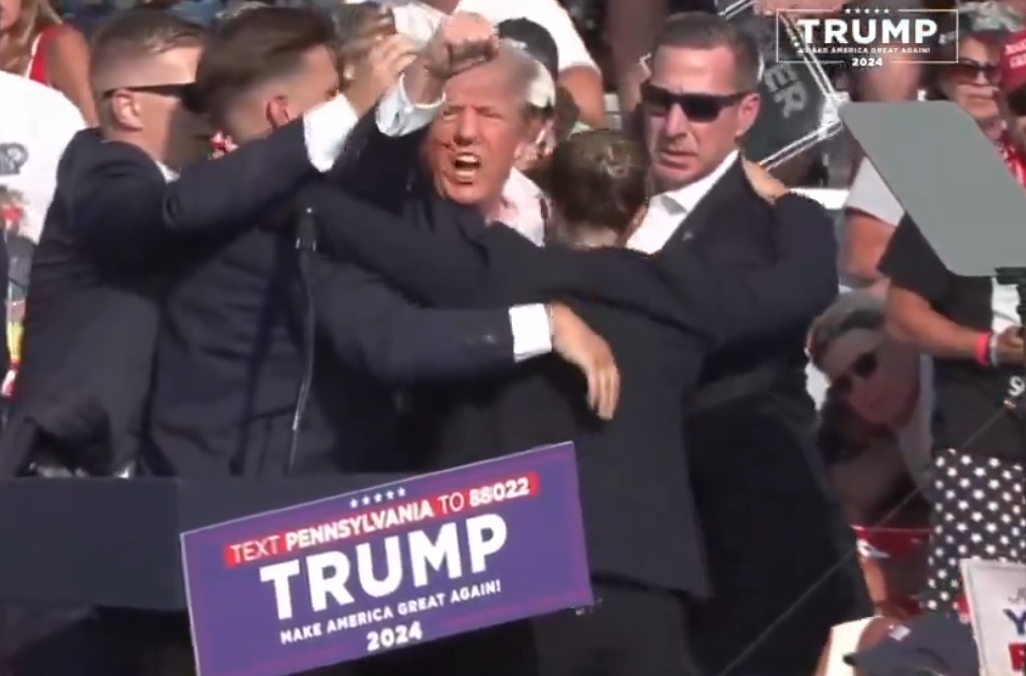
During the attempted assassination of former president Donald Trump, blood quickly ran down Trump’s face as bullets pierced through his right ear. On his first appearance at the Republican National Convention after the shooting, he showed up with white bandages covering his injured right ear. Later on the third day of the Republican National Convention, his republican supporters wore the same white bandages as a sign of resilience and support for Trump prior to his speech.
On July 13th of 2024, an assassination against Donald Trump was attempted during a campaign rally near Butler, Pennsylvania. Despite the shooter’s aim towards his head, his slight head movement seconds before the bullets and the swift actions of his security guard team prevented any serious injuries and death. Although the former president’s safety was ensured, three more people in the audience were seriously affected by the shooting. One person was killed and two others were seriously injured. The shooter was killed by a U.S. Secret Service sniper moments after firing his weapon.
Political violence has shaped the course of history, often with devastating consequences. The attempted assassination of former President Donald Trump serves as a reminder of the dangers of using violence as a means to achieve political ends. This incident not only highlights the personal risks faced by political figures but also underscores the broader societal impact of such violence.
The human cost of this political violence was immediately evident. Corey Comperatore, a 50 year old man was killed in the shooting while trying to shield his family from potential gunfire. He was remembered as a 50 year old loyal firefighter and a loving father. Five days after the incident on July 18th, his sacrifice was honored by Trump, who kissed his helmet out of respect and commemoration.
Two other victims of the shooting, Jim Copenhaver and David Dutch are recovering from life altering injuries in the hospital. Fortunately, further significant injuries were avoided as Dutch was discharged from the hospital eleven days after the shooting, on July 24th.
Political violence has far-reaching consequences beyond the immediate victims. It creates an atmosphere of fear and instability, undermining trust in political institutions and processes. The rally where Trump was targeted turned from a political event into a scene of chaos and trauma, affecting not only those present but the wider community as well.

The shooter was later identified to be Thomas Matthew Crooks, a 20 year old American man. He was armed with an AR-style rifle, firing 8 shots at his target, Donald Trump. Relating to his motive, he was registered with a membership at a local shooting club, where he would purchase fifty rounds daily, shooting up to targets 171 meters away.

His close acquaintances had mixed experiences and perspectives of him as some described him to be quiet but friendly while the others recalled him as an outcast who was often bullied. Though his motive is still unclear to this day, investigators discovered his attempts to “diagnose himself” as his research history of depressive disorders were found despite him never being formally diagnosed with a mental disorder prior to the shooting.
Crooks’ incident highlights the critical issue of mental health in the context of political violence. His attempts of self-diagnosis and his background suggest that mental health issues, when left unaddressed, contribute to violent actions. This highlights the importance of accessible mental health care and early intervention in preventing such tragedies.
The attempted assassination of Donald Trump is part of a broader historical pattern of political violence. Throughout history, political figures have been targeted in attempts to achieve justice or change through violent means. Notable examples include the assassinations of Abraham Lincoln, John F. Kennedy, and Martin Luther King Jr., which had profound impacts on American society.
Abraham Lincoln, the sixteenth president of America was the first president to be assassinated. On April 14th of 1865, he was shot in the head while watching the play Our American Cousin with his wife. The shot was fired by John Wilkes Booth driven by hatred for Lincoln’s policies, particularly the abolition of slavery and the defeat of the Confederacy. Lincoln’s assassination was part of a plan to assassinate the three important officials of the federal government. intended to revive the Confederate. Lincoln’s death dragged the nation into deeper depression during the Reconstruction era, highlighting how political hatred can have profound and far-reaching consequences.
The assassination of Dr. Martin Luther King Jr. happened on April 4th of 1968. The shooting was conducted by James Earl Ray who was driven by racial hatred and opposition to the Civil Rights Movement. His assassination was a significant blow to the Civil Rights Movement, sparking riots and widespread mourning. It underscored the pervasive and deadly impact of racial hatred in America.
The history of attempted assassination has continued through not only the history of America, but the history of hatred and violence. Violence has been used as an attempt of achieving justice and peace throughout the history of hatred.

The Nazi regime’s use of violence was justified under the guise of achieving peace through ethnic cleansing. The Holocaust, with its systematic persecution and genocide, is a brutal example of how perceived justice can be used to rationalize extreme violence.
With the ongoing war with Israel against Palestine, Ukraine against Russia, and countless more, hatred and violence remains as one of the most deadly and significant factors that shapes society to this day.
The deadly consequences of repeated and ongoing political violence are:
Societal Polarization: Acts of political violence deepen societal divisions, creating an “us versus them” mentality
Erosion of Trust: Violence erodes trust in political institutions and leaders, undermining the democratic process and the rule of law.
Cycle of Retaliation: Hatred-fueled violence often leads to a cycle of retaliation, where each act of violence begets further violence, perpetuating conflict and instability.
Human Cost: The immediate human cost of political violence is devastating, with lives lost and families torn apart. The long-term psychological impact on survivors and communities can be equally damaging.
Preventing political violence and addressing the underlying hatred requires a comprehensive approach. Tolerance is an extremely relevant factor in dealing with discrimination and achieving further peace.
The attempted assassination of Donald Trump and other historical examples of political violence highlight the destructive power of hatred in politics. By understanding the root causes and impacts of such violence, we as society can work towards creating a more tolerant, inclusive, and peaceful political environment. Addressing hatred in all its forms is essential in preventing future acts of political violence and ensuring the stability and health of democratic societies.

<Student Reporter Julie Kim>julierosekim0721@gmail.com
Julie Kim is a Sophomore Student in EF Academy Pasadena






